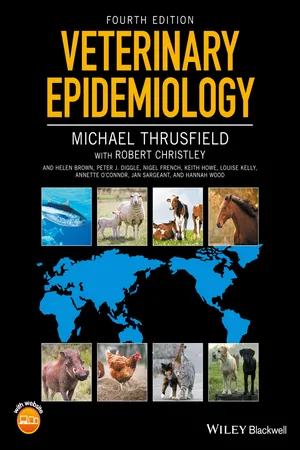
- English
- ePUB (mobile friendly)
- Available on iOS & Android
Veterinary Epidemiology
About This Book
A comprehensive introduction to the role of epidemiology in veterinary medicine
This fully revised and expanded edition of Veterinary Epidemiology introduces readers to the field of veterinary epidemiology. The new edition also adds new chapters on the design of observational studies, validity in epidemiological studies, systematic reviews, and statistical modelling, to deliver more advanced material.
This updated edition begins by offering an historical perspective on the development of veterinary medicine. It then addresses the full scope of epidemiology, with chapters covering causality, disease occurrence, determinants, disease patterns, disease ecology, and much more.
Veterinary Epidemiology, Fourth Edition:
? Features updates of all chapters to provide a current resource on the subject of veterinary epidemiology
? Presents new chapters essential to the continued advancement of the field
? Includes examples from companion animal, livestock, and avian medicine, as well as aquatic animal diseases
? Focuses on the principles and concepts of epidemiology, surveillance, and diagnostic-test validation and performance
? Includes access to a companion website providing multiple choice questions
Veterinary Epidemiology is an invaluable reference for veterinary general practitioners, government veterinarians, agricultural economists, and members of other disciplines interested in animal disease. It is also essential reading for epidemiology students at both the undergraduate and postgraduate levels.
Frequently asked questions
Information
1
The development of veterinary medicine
Table of contents
- Cover
- Title Page
- Table of Contents
- Contributors
- From the preface to the first edition
- From the preface to the second edition
- From the preface to the third edition
- Preface to the fourth edition
- About the companion website
- 1 The development of veterinary medicine
- 2 The scope of epidemiology
- 3 Causality
- 4 Describing disease occurrence
- 5 Determinants of disease
- 6 The transmission and maintenance of infection
- 7 The ecology of disease
- 8 Patterns of disease
- 9 Comparative epidemiology
- 10 The nature of data
- 11 Data collection and management
- 12 Presenting numerical data
- 13 Surveys
- 14 Demonstrating association
- 15 Observational studies
- 16 Design considerations for observational studies
- 17 Clinical trials
- 18 Validity in epidemiological studies
- 19 Systematic reviews
- 20 Diagnostic testing
- 21 Surveillance
- 22 Statistical modelling
- 23 Mathematical modelling
- 24 Risk analysis
- 25 Economics and veterinary epidemiology
- 26 Health schemes
- 27 The control and eradication of disease
- General reading
- Appendices
- Appendix I: Glossary of terms
- Appendix II: Basic mathematical notation and terms
- Appendix III: Some computer software
- Appendix IV: Veterinary epidemiology on the Internet
- Appendix V: Student’s t‐distribution
- Appendix VI: Multipliers used in the construction of confidence intervals based on the Normal distribution, for selected levels of confidence
- Appendix VII: Values of exact 95% confidence limits for proportions
- Appendix VIII: Values from the Poisson distribution for calculating 90%, 95% and 99% confidence intervals for observed numbers from 0 to 100
- Appendix IX: The χ2 distribution
- Appendix X: Technique for selecting a simple random sample
- Appendix XI: Sample sizes
- Appendix XII: The probability of detecting a small number of cases in a population
- Appendix XIII: The probability of failure to detect cases in a population
- Appendix XIV: Sample sizes required for detecting disease with probability, p1, and threshold number of positives
- Appendix XV: Probabilities associated with the upper tail of the Normal distribution
- Appendix XVI: Lower‐ and upper‐tail probabilities for Wx, the Wilcoxon–Mann–Whitney rank‐sum statistic
- Appendix XVII: Critical values of T+ for the Wilcoxon signed ranks test
- Appendix XVIII: Values of K for calculating 95% confidence intervals for the difference between population medians for two independent samples
- Appendix XIX: Values of K* for calculating 95% confidence intervals for the difference between population medians for two related samples
- Appendix XX: Common logarithms (log10) of factorials of the integers 1–999
- Appendix XXI: The correlation coefficient
- Appendix XXII: The variance‐ratio (F) distribution
- References
- Index
- End User License Agreement